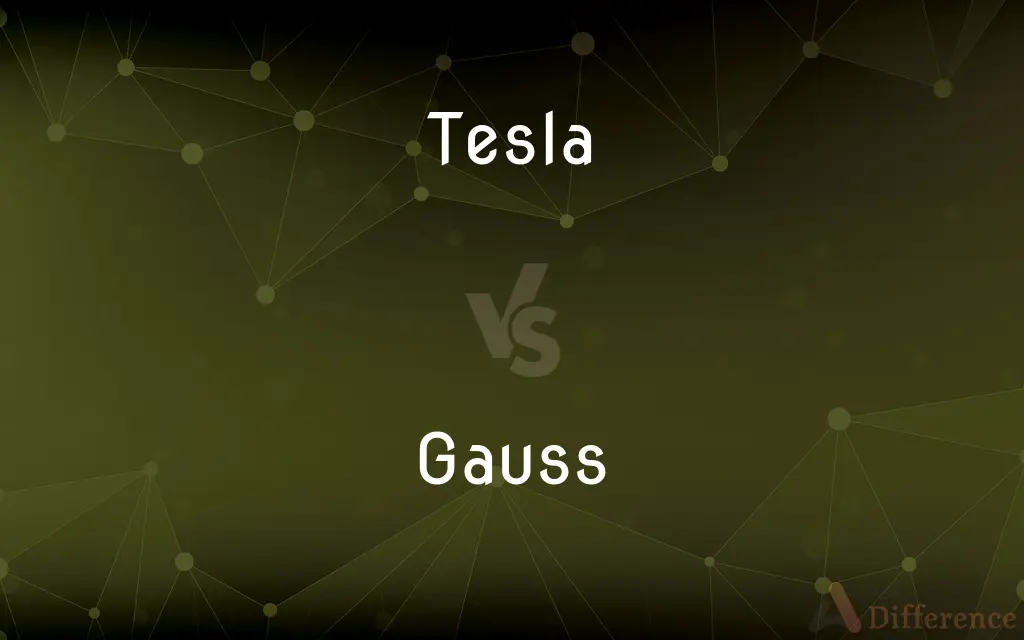Tesla vs. Gauss — What's the Difference?
By Tayyaba Rehman — Updated on November 5, 2023
Tesla (T) is the SI unit of magnetic field strength, while Gauss (G) is the CGS unit, with 1 T equaling 10,000 G.

Difference Between Tesla and Gauss
Table of Contents
ADVERTISEMENT
Key Differences
Tesla and Gauss are both units of magnetic flux density or magnetic induction, but they belong to different measurement systems. Tesla is part of the International System of Units (SI), and Gauss is part of the centimeter-gram-second (CGS) system of units. The Tesla is a larger unit compared to Gauss, reflecting the difference in scale between the two systems.
One Tesla represents one weber per square meter, the SI unit for magnetic flux spread out over an area. On the other hand, Gauss, being a smaller unit, is more convenient for use in scientific contexts where magnetic fields are weaker. For example, the Earth's magnetic field is typically measured in Gauss.
While Tesla is the standard unit used in most scientific research, Gauss is still commonly used in certain fields and countries. Magnetic resonance imaging (MRI), for example, often refers to Tesla when specifying the strength of the magnets used. The choice between Tesla and Gauss can depend on the convention of the field of study and the magnitude of the magnetic fields being measured.
A key point is that Tesla and Gauss measure the same physical quantity, and thus one can be converted to the other. Specifically, one Tesla equals 10,000 Gauss. Despite this difference in magnitude, they both serve to quantify the concentration of magnetic lines of force in a given area.
The usage of Tesla and Gauss can also indicate the era or region of a scientific work, with newer global publications tending to use Tesla, while older or more localized publications may use Gauss. It is also worth noting that both units are named after prominent scientists: Nikola Tesla and Carl Friedrich Gauss, reflecting their respective contributions to the field of electromagnetism.
ADVERTISEMENT
Comparison Chart
Measurement System
SI (International System of Units)
CGS (centimeter-gram-second system)
Unit Size
Larger unit, 1 T = 10,000 G
Smaller unit
Usage
Common in modern scientific research
Often used in specific fields and older scientific literature
Magnitude
Used for strong magnetic fields
Used for weaker magnetic fields
Named After
Nikola Tesla
Carl Friedrich Gauss
Compare with Definitions
Tesla
A unit of magnetic flux density in the SI system.
The MRI machine operates at a strength of 3 Tesla.
Gauss
A unit of measurement for magnetic fields in the CGS system.
The Earth's magnetic field is about 0.5 Gauss.
Tesla
Denotes a strong magnetic field in scientific contexts.
The lab's electromagnet can generate up to 5 Tesla.
Gauss
A smaller unit of magnetic flux density.
The bar magnet had a strength of 100 Gauss.
Tesla
A measure of magnetic field strength.
Superconducting magnets often exceed 10 Tesla.
Gauss
Used in older scientific literature for magnetic measurements.
The paper from the 1950s reported magnetic values in Gauss.
Tesla
The standard unit for magnetic induction.
Researchers measured the field in Tesla to ensure accuracy.
Gauss
Can indicate the scale of magnetism in certain research fields.
Biologists measure the magnetic orientation of birds in Gauss.
Tesla
Used to describe the intensity of magnetic fields.
High-energy physics experiments require fields of several Tesla.
Gauss
Often used in physics for describing weak magnetic fields.
He detected a slight disturbance of 2 Gauss in the magnetic field.
Tesla
The SI-derived unit of magnetic flux density, equal to the magnitude of the magnetic field vector necessary to produce a force of one newton on a charge of one coulomb moving perpendicular to the direction of the magnetic field vector with a velocity of one meter per second. It is equivalent to one weber per square meter. See Table at measurement.
Gauss
The centimeter-gram-second unit of magnetic flux density, equal to one maxwell per square centimeter.
Tesla
In the International System of Units, the derived unit of magnetic flux density or magnetic inductivity. Symbol: T
Gauss
The unit of magnetic field strength in CGS systems of units, equal to 0.0001 tesla.
Tesla
A unit of magnetic flux density equal to one weber per square meter
Gauss
The C.G.S. unit of density of magnetic field, equal to a field of one line of force per square centimeter, being thus adopted as an international unit at Paris in 1900; sometimes used as a unit of intensity of magnetic field. It was previously suggested as a unit of magnetomotive force.
Tesla
United States electrical engineer and inventor (born in Croatia but of Serbian descent) who discovered the principles of alternating currents and developed the first alternating-current induction motor and the Tesla coil and several forms of oscillators (1856-1943)
Gauss
Karl F. Gauss, a German mathematician.
Gauss
A unit of magnetic flux density equal to 1 maxwell per square centimeter
Gauss
German mathematician who developed the theory of numbers and who applied mathematics to electricity and magnetism and astronomy and geodesy (1777-1855)
Common Curiosities
Why is Tesla the preferred unit in modern science?
It aligns with the SI units, which are globally standardized.
Is Gauss still used today?
Yes, particularly in fields dealing with small magnetic fields.
What is typically measured in Tesla?
Strong magnetic fields, like those in MRI machines.
What is commonly measured in Gauss?
Earth's magnetic field and smaller magnets are measured in Gauss.
Are there scientific instruments calibrated in Gauss?
Yes, some magnetic field sensors are calibrated in Gauss.
What do Tesla and Gauss have in common?
Both are units for measuring magnetic flux density.
Can Tesla and Gauss be directly compared?
1 Tesla is equal to 10,000 Gauss.
Who was the unit Tesla named after?
Nikola Tesla, a pioneer in electromagnetism.
Why are different units used for magnetic fields?
It often depends on historical context and field of study.
Can consumer products generate fields measured in Tesla?
Rarely, as such strong fields are generally industrial or scientific.
How do you convert Gauss to Tesla?
Divide the number of Gauss by 10,000.
Who was the unit Gauss named after?
Carl Friedrich Gauss, a German mathematician and physicist.
Is Gauss ever used in medical imaging?
Typically, medical imaging uses Tesla.
Did Tesla and Gauss work on magnetic fields?
Yes, both made significant contributions to electromagnetism.
What are milligauss and microtesla?
These are smaller subdivisions used for very weak fields.
Share Your Discovery

Previous Comparison
Humph vs. Hmph
Next Comparison
Peck vs. BushelAuthor Spotlight
Written by
Tayyaba RehmanTayyaba Rehman is a distinguished writer, currently serving as a primary contributor to askdifference.com. As a researcher in semantics and etymology, Tayyaba's passion for the complexity of languages and their distinctions has found a perfect home on the platform. Tayyaba delves into the intricacies of language, distinguishing between commonly confused words and phrases, thereby providing clarity for readers worldwide.














































